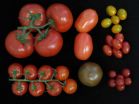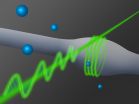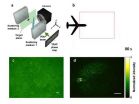(Press-News.org) Cold Spring Harbor, NY – Scientists at Cold Spring Harbor Laboratory (CSHL) today announced a new way to dramatically increase crop yields by improving upon Mother Nature's offerings. A team led by Associate Professor Zachary Lippman, in collaboration with Israeli colleagues, has discovered a set of gene variations that can boost fruit production in the tomato plant by as much as 100%.
Plant breeders will be able to combine different gene variants among the set to create an optimal plant architecture for particular varieties and growing conditions. The set of mutations will enable farmers to maximize yield in tomatoes and potentially many other flowering plants, including staple crops like soybeans.
"Traditionally, plant breeders have relied on natural variation in plant genes to increase yield, but yield gains are plateauing," Lippman notes. "There is an immediate need to find new ways for plant breeders to produce more food." Worldwide more than 842 million people do not receive adequate nourishment, about 1 person in 8 alive today. The cost of food is expected to increase and hunger is likely to become more widespread as the global population expands to beyond 9 billion by 2050.
Ancient humans and early plant breeders recognized that selecting plants with modified architectures could have a major impact on the amount of fruit they produce. In general scientific terms, Lippman explains, "Plant architecture results from a delicate balance between vegetative growth – shoots and leaves – and flower production. To increase crop yields, we want plants to produce as many flowers and fruits as possible, but this requires energy – energy that is produced in leaves."
In tomatoes and all other flowering plants, the balance between vegetative growth and flowers is controlled by a pair of opposing hormones, called florigen and anti-florigen. Prior work by Lippman and Israeli colleagues showed that a mutation in florigen can shift the balance between vegetative growth and flowering, modifying plant architecture in a way that increases yield. This suggested that the balance between florigen and anti-florigen might not yet be optimal in tomato plants, despite centuries of breeding with natural variants.
In a study published today in Nature Genetics, Lippman's team identifies an array of new gene mutations that allow, for the first time, a way to fine-tune the balance of florigen to anti-florigen. This maximizes fruit production without compromising the energy from leaves needed to support those fruits. "We mixed and matched all of the mutations," explains Lippman. "And we were able to produce plants with a broad range of architectures. Together, our collection of mutations forms a powerful toolkit for breeders to pinpoint a new optimum in flowering and architecture that can achieve previously unattainable yield gains."
The breakthrough benefit of the toolkit, says Lippman, is that it allows farmers to customize genetic variations for particular varieties and growing conditions. "For example, we found that different combinations boost yields for cherry tomatoes and other fresh-market tomatoes compared to tomatoes that are processed for sauce, ketchup, and other canned products. We've tested this in multiple genetic backgrounds, in multiple years, and in multiple environments – and the toolkit always provides a new maximum yield."
These results are likely to be broadly applicable to other flowering crops, Lippman says. Mutations that affect florigen and anti-florigen are already known to play a role in controlling plant architecture for the oil crops rapeseed and sunflower, and can be applied in those. But the team is anxious to move on to critical food crops, specifically soybeans, which share many growth similarities with tomato.
INFORMATION:
This work was supported by grants from a European Research Council-Advanced (ERC), the Israeli Science Foundation (ISF), the Binational Agricultural and Research Fund (BARD), and the National Science Foundation (NSF) Plant Genome Research Program.
"Optimization of crop productivity in tomato using induced mutations in the florigen pathway" appears online in Nature Genetics on November 2, 2014. The authors are: Soon Ju Park, Ke Jiang, Lior Tal, Yoav Yichie, Oron Gar, Dani Zamir, Yuval Eshed, and Zachary Lippman. The paper can be obtained online at: http://www.nature.com/ng/index.html
About Cold Spring Harbor Laboratory Founded in 1890, Cold Spring Harbor Laboratory (CSHL) has shaped contemporary biomedical research and education with programs in cancer, neuroscience, plant biology and quantitative biology. CSHL is ranked number one in the world by Thomson Reuters for the impact of its research in molecular biology and genetics. The Laboratory has been home to eight Nobel Prize winners. Today, CSHL's multidisciplinary scientific community is more than 600 researchers and technicians strong and its Meetings & Courses program hosts more than 12,000 scientists from around the world each year to its Long Island campus and its China center. For more information, visit http://www.cshl.edu.
A new study of the Amazon River basin shows lowland rivers that carry large volumes of sediment meander more across floodplains and create more oxbow lakes than rivers that carry less sediment.
The findings have implication for the Amazonian river system, which may be significantly altered by proposed mega-dams that would disrupt sediment supplies.
Researchers from Cardiff University's School of Earth and Ocean Sciences examined 20 reaches within the Amazon Basin from Landsat imagery spanning nearly 20 years (1985 to 2013).
They found rivers transporting larger amounts ...
CINCINNATI—An antibody abundant in mice and previously thought to offer poor assistance in fighting against infection may actually play a key role in keeping immune responses in check and preventing more serious self-inflicted forms of kidney disease, researchers say.
Led by researchers at the University of Cincinnati (UC) and Cincinnati Children's Hospital Medical Center and published online Nov. 2, 2014, in the journal Nature, the study finds that the mouse antibody IgG1, which is made in large quantities and resembles a human antibody known as IgG4, may actually ...
Two photons in free space do not interact. Light waves can pass through each other without having any influence on each other at all. For many applications in quantum technology, however, interaction between photons is crucial. It is an indispensable prerequisite for transmitting information through tap-proof quantum channels or for building optical logic gates. At the Vienna University of Technology (TU Wien), scientists have now succeeded in establishing a strong interaction between two single photons. This opens up completely new possibilities for quantum optics. The ...
As a child, it was fascinating to put a flashlight up to our palms to see the light shine through the hand. Washington University in St. Louis engineers are using a similar idea to track movement inside the body's tissues to improve imaging of cancerous tissues and to develop potential treatments.
Lihong Wang, PhD, the Gene K. Beare Distinguished Professor of Biomedical Engineering at the School of Engineering & Applied Science is applying a novel time-reversal technology that allows researchers to better focus light in tissue, such as muscles and organs.
Current ...
Nate Silver and Richard Feynman walk into a bar and bump into a biologist . . .
While this may sound like the setup to some late-night nerd sketch, researchers have taken this premise and applied it to an increasingly cumbersome problem in modern biology, namely, finding meaning in the rising oceans of genomic data.
In this specific instance, the data comprisesreams of cancer mutations that genome-wide studies are publishing at a dizzying rate. The challenge is finding new and efficient ways to parse the signal from the noise (and there is no shortage of noise).
As ...
A disappearing act was the last thing Rice University physicist Randy Hulet expected to see in his ultracold atomic experiments, but that is what he and his students produced by colliding pairs of Bose Einstein condensates (BECs) that were prepared in special states called solitons.
Hulet's team documented the strange phenomenon in a new study published online this week in the journal Nature Physics.
BECs are clumps of a few hundred thousand lithium atoms that are cooled to within one-millionth of a degree above absolute zero, a temperature so cold that the atoms march ...
Antibodies, in charge of recognizing and homing in on molecular targets, are among the most useful tools in biology and medicine. Nanobodies – antibodies' tiny cousins – can do the same tasks, for example marking molecules for research or flagging diseased cells for destruction. But, thanks to their comparative simplicity nanobodies offer the tantalizing prospect of being much easier to produce.
Unfortunately, their promise hasn't been fully realized, because scientists have lacked an efficient way of identifying the nanobodies most closely tuned to their ...
Invisible tattoos could replace the permanent dark ink tattoos used to ensure that breast cancer patients having radiotherapy are treated in exactly the same spot during each session, according to results from a pilot study to be presented at the National Cancer Research Institute (NCRI) Cancer Conference today (Sunday)*.
Research suggests that the permanent pin prick marks made on the skin of women having radiotherapy reminds them of their diagnosis for years to come, reducing body confidence and self-esteem.
It's also more difficult to spot these tattoos in dark-skinned ...
Scientists have identified more than 800 markers in the blood of cancer patients that could help lead to a single blood test for early detection of many types of cancer in future, according to research presented at the National Cancer Research Institute (NCRI) Cancer Conference in Liverpool today (Sunday).
This is the first time that cancer-specific blood markers have been comprehensively reviewed and identified for further clinical development. This study, by the UK Early Cancer Detection Consortium*, funded by Cancer Research UK, has analysed 19,000 scientific papers ...
Charlottesville, VA (November 1, 2014). The Journal of Neurosurgery Publishing Group is pleased to announce today's publication of "Pediatric hydrocephalus: systematic literature review and evidence-based guidelines," a supplement to the November issue of the Journal of Neurosurgery: Pediatrics. Authored by a volunteer task force from the pediatric neurosurgery community, the supplement offers a thorough evaluation of the current treatments for pediatric hydrocephalus as well as up-to-date evidence-based recommendations for their use.
Hydrocephalus is a condition in which ...




